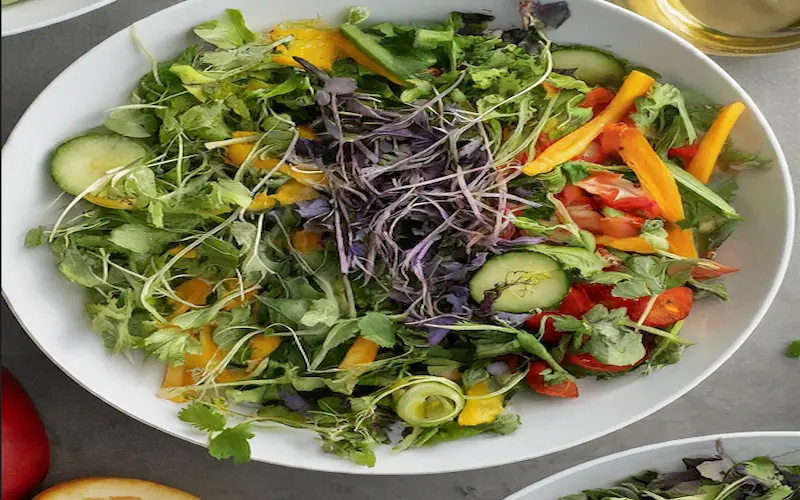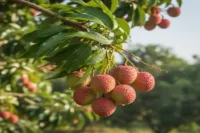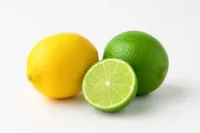Step-by-Step Guide to Making Microgreen Salads
Published: 10 Oct 2025
Microgreens are tiny young plants packed with flavor, color, and nutrition. These little greens have become a favorite in healthy eating because they’re rich in vitamins, minerals, and antioxidants. Their fresh taste and bright colors make any dish look more appetizing and full of life.
What makes microgreens even better is how easy they are to use. You don’t need fancy cooking skills or special tools—just a handful of these vibrant greens can turn a simple meal into something healthy and delicious.
This guide will show you exactly how to make microgreen salads step by step. It’s designed for beginners who want to enjoy fresh, crunchy, and nutrient-rich salads at home without any stress. Want to add freshness and nutrition to your meals? Learn how to make microgreen salads right at home with this easy, beginner-friendly guide.

What are microgreens?
Microgreens are tiny, young plants that are harvested just a few days after they start growing. They’re small in size but big in flavor and nutrients. You can think of them as baby versions of your favorite vegetables and herbs.
Unlike sprouts, which are grown in water and eaten with their roots, microgreens are grown in soil or trays, and only the leaves and stems are harvested. They also have a more developed taste compared to sprouts and a softer texture than mature greens like spinach or lettuce.
Some popular types of microgreens you can use in salads include:
- 🌻 Sunflower microgreens – mild, nutty, and crunchy.
- 🌿 Radish microgreens – spicy and full of flavor.
- 🥬 Pea shoots – sweet and tender, great for a light salad.
- 🥦 Broccoli microgreens – fresh and slightly peppery.
These tiny greens are rich in vitamins A, C, and K, along with minerals like iron, magnesium, and potassium. They’re also loaded with antioxidants that help your body stay healthy and energized.

Why Choose Microgreen Salads?
Microgreen salads are one of the easiest and healthiest meals you can make. They’re light, colorful, and full of flavor — perfect for anyone who wants to eat fresh without spending much time in the kitchen.
Here’s why so many people love them:
- Quick to prepare: You can make a microgreen salad in just a few minutes. No cooking or special equipment needed.
- Packed with nutrients: Microgreens are rich in vitamins, minerals, and antioxidants that help boost your energy and support overall health.
- Great for weight loss and detox diets: They’re low in calories but high in fiber, making you feel full while keeping your meals light and healthy.
- Adds color, crunch, and taste: The mix of fresh greens and toppings makes every bite refreshing and satisfying.
- Perfect for everyone: Whether you’re a vegetarian, vegan, or enjoy meat, microgreen salads cater to every diet.
- Pairs well with many foods: You can enjoy them with light dressings or add protein sources like eggs, beans, or grilled chicken for a complete meal.
Microgreen salads are a simple way to bring more freshness and nutrition to your table — every bowl is a boost of health and flavor! “If you love growing your own greens, check out our guide on Top 10 Most Profitable Vegetables to Grow to learn which vegetables pair well with your salads.”
What You Need Before You Start
Before you dive into making your first microgreen salad, it’s good to have a few simple things ready. Don’t worry — you don’t need fancy kitchen gear or expert skills. A few basic tools and ingredients are all it takes to make your salad fresh, colorful, and delicious.
Here’s what you’ll need:
- Fresh Microgreens: These are the heart of your salad. Choose clean, crisp greens like sunflower, radish, or pea shoots for the best taste and texture.
- Clean Salad Bowl: A medium-sized bowl helps you mix your ingredients evenly without crushing the delicate microgreens.
- Sharp Knife and Cutting Board: For slicing vegetables and fruits neatly. A sharp knife keeps your cuts clean and prevents bruising the produce.
- Salad Spinner or Paper Towels: Used to dry your microgreens after washing. Removing extra water keeps the salad light and crisp.
- Fresh Vegetables or Add-ins: Simple items like cucumber, tomato, or avocado add color and crunch. You can also use nuts, cheese, or fruits for extra flavor.
- Small Whisk or Spoon: Handy for mixing your dressing evenly. This helps coat every leaf without making the salad soggy.
- Basic Kitchen Knowledge: Knowing how to wash and handle greens gently makes a big difference in how your salad turns out.
Having these ready before you start will make the process smoother and more enjoyable — so you can focus on the fun part: creating your own fresh, healthy microgreen salad!
Ingredients You Will Need
Making a microgreen salad doesn’t require many ingredients. Most of what you need is already in your kitchen. The key is to use fresh, clean, and colorful ingredients to make your salad both healthy and tasty.
Here’s what you’ll need to get started:
- 🥗 2 cups of mixed microgreens: Use any mix you like—sunflower, radish, pea shoots, or broccoli microgreens all work great.
- 🥒 1 small cucumber (sliced): Adds a cool, crisp texture to your salad.
- 🍅 1 medium tomato (chopped): Brings color and natural sweetness.
- 🥑 ½ avocado (optional): Gives your salad a creamy touch and healthy fats.
- 🍋 1 tablespoon lemon juice or vinegar: Adds a light, tangy flavor to balance the greens.
- 🫒 2 tablespoons olive oil: Works as the base for your dressing and adds healthy fats.
- 🧂 Salt and pepper to taste: Simple seasoning brings out all the natural flavors.
- 🧀 Optional add-ins: Try nuts, seeds, boiled egg, or feta cheese for extra crunch and protein.
💡 Tip: Always wash and dry your microgreens before using them. It keeps the salad fresh and crisp.
With these basic ingredients, you’re ready to create a fresh and colorful microgreen salad that’s full of nutrition and flavor!
Step-by-Step Process: How to Make Microgreen Salads
Making a microgreen salad is simple once you know the right steps. You don’t need fancy tools or cooking skills — just a few minutes and fresh ingredients. Follow these easy steps, and you’ll have a fresh, healthy salad ready to enjoy in no time!

Step 1: Wash the Microgreens Gently
Start by washing your microgreens under cool running water. Hold them softly so you don’t crush the tiny leaves. Rinse them two or three times to remove any dirt or dust. Then, use a salad spinner or clean paper towel to dry them well.
💡 Tip: Dry greens mix better with the dressing and stay crisp longer.
Step 2: Prepare the Vegetables and Add-ins
Now, gather your favorite add-ins. You can use cucumber, tomato, bell pepper, or even avocado. Wash them well and chop them into small, bite-sized pieces.
If you want extra crunch or protein, keep some nuts, seeds, boiled egg, or cheese ready. These toppings make your salad more filling and flavorful.
Step 3: Mix Everything in a Bowl
Take a clean salad bowl and add your microgreens first. Then, toss in your chopped vegetables and any other add-ins you like. Mix them gently with your hands or a spoon. Be careful not to press too hard—microgreens are delicate and can bruise easily.
Step 4: Prepare the Dressing
In a small bowl, whisk together 2 tablespoons of olive oil, 1 tablespoon of lemon juice, a pinch of salt, and a little pepper.
You can also try honey or vinegar if you like a sweeter or tangier taste. Stir until everything blends smoothly.
💡 Tip: Keep the dressing light — too much can make your greens soggy.
Step 5: Combine and Toss Lightly
Now, pour the dressing over your salad. Use a spoon or your clean hands to toss everything gently until the dressing coats all the ingredients.
Make sure the microgreens stay fluffy and don’t stick together.
Step 6: Add Final Touches
Once your salad is well mixed, sprinkle your favorite toppings — like crushed nuts, seeds, or a few cubes of cheese.
For a burst of flavor, you can also add fresh herbs like mint or basil. These small touches make your salad more colorful and appetizing.
Step 7: Serve Fresh and Enjoy
Your microgreen salad is now ready to eat! Serve it right away to enjoy its crisp texture and fresh flavor.
If you need to wait a few minutes before serving, keep it in a cool place but avoid refrigerating it for too long — that can dull the taste and texture.
Extra Tips and Best Practices
Here are some simple tips to help you make the best microgreen salads every time. Follow these easy steps to keep your salads fresh, colorful, and tasty.
- Use fresh microgreens. Always pick greens that look bright and crisp. Old or wilted ones lose flavor fast.
- Wash gently. Microgreens are delicate. Handle them softly to keep their shape.
- Dry completely. Wet greens make your salad soggy. Use a paper towel or salad spinner.
- Mix right before serving. Dress the salad only when you’re ready to eat. It keeps the greens crunchy.
- Go light on dressing. Too much dressing hides the natural flavor of microgreens.
- Try different combinations. Mix spicy radish greens with mild pea shoots for balance.
- Add fruits for sweetness. Apples, oranges, or strawberries make great pairings.
- Use nuts and seeds. They add crunch and healthy fats to your salad.
- Avoid overmixing. Toss gently so you don’t crush the greens.
- Serve fresh. Microgreen salads taste best when eaten right away.
💡 Small tip: Keep microgreens in a cool, dry place before use — this helps them stay crisp longer.
Common Problems and Fixes
Even simple salads can go wrong sometimes — and that’s okay! Here are some common problems people face when making microgreen salads and quick ways to fix them.
- Problem: The salad turns soggy.
Fix: Dry your microgreens completely before adding dressing. Use a salad spinner or clean towel. - Problem: The greens taste bitter.
Fix: Mix mild microgreens like pea shoots or sunflower with stronger ones like radish to balance the flavor. - Problem: The dressing feels too heavy.
Fix: Use less oil and more lemon juice or vinegar for a lighter, fresher taste. - Problem: The salad looks dull or colorless.
Fix: Add bright veggies like tomatoes, bell peppers, or shredded carrots for color and crunch. - Problem: The salad feels bland.
Fix: Add toppings like cheese, roasted nuts, or a pinch of salt and pepper to lift the flavor. - Problem: The microgreens wilt too fast.
Fix: Store them in the fridge wrapped in a damp paper towel. Don’t wash them until you’re ready to use. - Problem: The ingredients don’t mix well.
Fix: Toss everything gently with clean hands or a large spoon to coat evenly without crushing. - Problem: The salad doesn’t stay fresh.
Fix: Always make it right before eating. Avoid leaving dressed salad for more than 15–20 minutes. - Problem: Some microgreens feel gritty.
Fix: Rinse them twice in clean water to remove any soil or dust before drying. - Problem: Too many strong flavors.
Fix: Stick to two or three types of microgreens per salad for a balanced, mild taste.
FAQs about Microgreen Salads
Here are the main frequently asked questions about the topic.
Microgreens are tiny young plants harvested just after they sprout. They’re packed with vitamins, minerals, and flavor. You can grow them at home or buy them fresh from the market. They’re perfect for adding color and crunch to salads.
Yes! You can use almost any kind of microgreens. Popular choices include sunflower, pea shoots, radish, and broccoli. Try mixing mild and spicy types to get a balanced flavor in your salad.
Dry them gently with paper towels or a salad spinner. Then store them in an airtight container with a dry paper towel inside. Keep them in the fridge, but don’t let them stay wet — moisture makes them spoil faster.
Light dressings are best because microgreens have a delicate texture. Olive oil with lemon juice or vinegar tastes great. You can also try a simple yogurt-based dressing for a creamy touch. Always add dressing right before serving.
Conclusion
Now you know how to make microgreen salads from start to finish. You’ve learned how to choose fresh greens, mix the right ingredients, and create a salad that’s full of color, crunch, and flavor. With just a little practice, you can turn simple greens into a healthy and tasty meal anytime.
Keep trying new combinations and dressings to find your favorite flavor mix. You can even grow your own microgreens at home to make your salads fresher and more fun.
So grab your bowl, pick your greens, and start creating your own fresh and healthy microgreen salads today — one small step toward a brighter, greener lifestyle!

- Be Respectful
- Stay Relevant
- Stay Positive
- True Feedback
- Encourage Discussion
- Avoid Spamming
- No Fake News
- Don't Copy-Paste
- No Personal Attacks



- Be Respectful
- Stay Relevant
- Stay Positive
- True Feedback
- Encourage Discussion
- Avoid Spamming
- No Fake News
- Don't Copy-Paste
- No Personal Attacks



